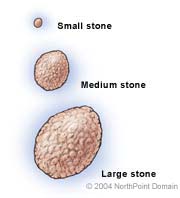Stone Evaluation

Basic Facts
- Stone analysis is a test done after a patient has passed a urinary stone or has had the stone removed.
- Medical stone evaluation provides valuable information about the type of urinary tract stones that have formed or are likely to form again.
- By knowing the stone’s chemical composition, as well as the composition of stone-forming substances within the urine, physicians can recommend preventive measures to lessen the likelihood of new stones forming or growth of existing stones.
Urinary stones, or calculi, are hardened, rock-like accumulations that form from mineral salts that occur naturally in the urine. Most often they form in the kidneys, and for this reason they are often referred to as kidney stones. Stone evaluation is performed after a patient has been treated for a urinary stone. The test either follows surgery to remove the stone or after a patient has passed the stone, collected it, and delivered it to the physician. The test is important to help the patient understand why the stone formed and how to prevent future stones from developing. Urine collections over a 24-hour period, which are used to assess levels of calcium, oxalate, uric acid, citrate, pH, sodium, and total volume, provide valuable evidence for the detection of underlying metabolic problems.The usual types of stones identified in a stone analysis include:
- Calcium;
- Struvite;
- Uric acid; or
- Cystine.
CALCIUM STONES
Between 70 and 80 percent of all urinary calculi are made up of calcium oxalate, calcium phosphate, or a combination of these two mineral crystals. Calcium stones occur more often in men than in women (in a ratio of about 3 to 1). Some people have high levels of calcium in the urine (a condition called hypercalciuria), and this excess calcium in the urine can cause a stone to form.
STRUVITE STONES
Struvite stones are made up of magnesium, ammonia, and phosphate (though some may contain calcium as well) and normally result from bacterial urinary infections. The bacteria produce urease, an enzyme that promotes the development of struvite crystals by making the urine alkaline. The most common bacteria associated with struvite stones is Proteus mirabilis.
URIC ACID STONES
Uric acid stones form when there is too much acid in the urine. Not surprisingly, this type of stone is closely related to diet and most often affects people who consume large quantities of animal protein. Uric acid stones occur in approximately 8 percent of stone patients, most of whom are men.
CYSTINE STONES
Cystine stones are rare, accounting for only about 1 percent of all urinary stones. They occur equally often in men and women, frequently in a person’s teens or twenties.
Copyright © 2017 NorthPoint Domain, Inc. All rights reserved.
This material cannot be reproduced in digital or printed form without the express consent of NorthPoint Domain, Inc. Unauthorized copying or distribution of NorthPoint Domain’s Content is an infringement of the copyright holder’s rights.

